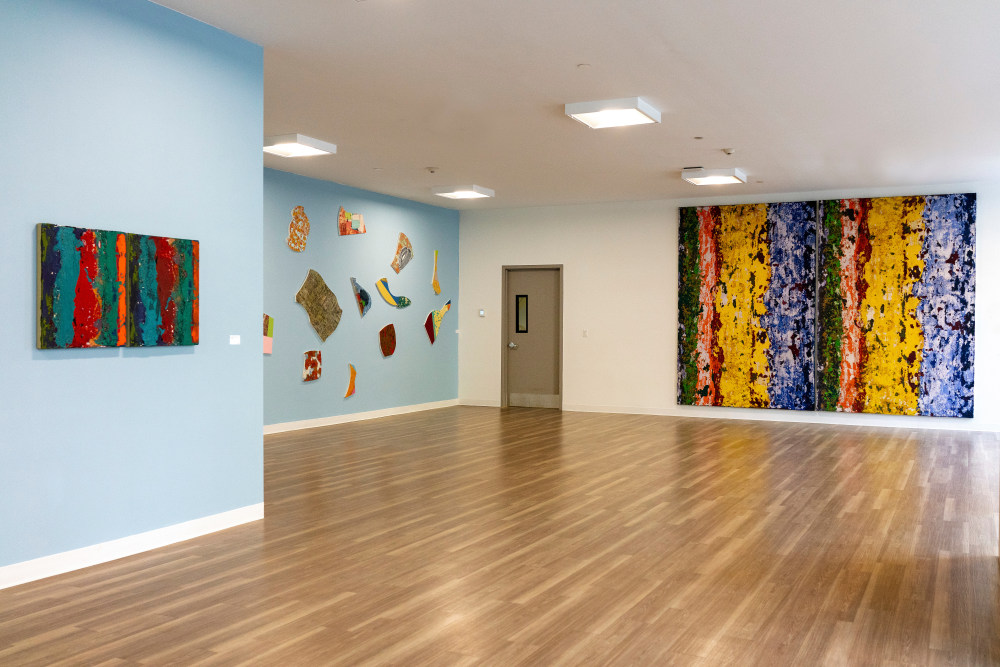
ART SPIEL
Reflections on the work of contemporary artists
POSTED ONOCTOBER 21, 2022 BY ANNE SHERWOOD PUNDYK
Rainer Gross: Double Take, Solo Exhibition at East End Arts, Riverhead, NY
In Double Take, Rainer Gross’ solo show at East End Arts through November 5, 2022 in Riverhead, NY, the artist invites the viewer to take a step closer to his abstract, intensely colorful paintings. Gross offers the viewer the satisfying experience of engaging intellectually with the underlying organizing principle of his compositions while savoring a sumptuously layered array of the results. His paintings are comprised of two (sometimes four) identically sized, stretched rectangular canvases shown side-by-side. He applies pools, bands, bars and patches of saturated hues of oil paint on one canvas and water-based pigment on the other. While the colors are still wet, the paired canvases are then placed together, face to face. When pulled apart, the forms on one canvas imprint on the other creating a shared Rorschach-like result. The artist refers to his paintings as “twins.” The side-by-side canvases are nearly identical, yet their differences become an intriguing puzzle to recognize, trace and sort. This easy-to-grasp concept offers a frisson of delight for the viewer as they experience the variety of its execution.
Appropriately, Double Take, is split between two locations at East End Arts. Works may be viewed at their main headquarters, a converted residential structure and at a large, open re- purposed commercial space several blocks away. The most engaging paintings in the show are from 2021 and 2022. Examples of these can be found at both galleries. These recent works have broad vertical bands of color in a deep autumn color palette such as in Brennan Twins (2022.) The muscular bands of paint sometimes pull away from their loose regimentation taking on a figure-like form as in Koopman Twins (2022.) The power of these newest works comes from their compositional reference to the body. There is a discernible sense of mirroring the viewer, creating an effect of figure and ground, that plays against the notion of the works as being entirely abstract.
The earlier meditative paintings from 2017 – 2020 reveal a more homogenous treatment of the picture plane such as Anderson Twins (2017.) All the paintings in the show, however, invite the viewer to step closer as they decode each pair of canvases. Passages of tinted fabric can be seen between sections of caked deep reds, citrus yellows, and blue/blacks. Up close, loose looking cracks and flakes of contrasting colored paint seem to dance perilously over the surface.
The artist references an interdisciplinary art movement from the 1960s and ‘70s, Fluxus, as a source of inspiration for this body of work. Fluxus artists in both America and Europe embraced the “doing” over the resulting completed art object. The American artist and musician John Cage and the German artist Joseph Beuys, among many other Fluxus artists, celebrated the performance aspect of manipulating raw art materials with its focus on chance and the present moment over a preconceived conclusion. And, the work has a direct connection to the Abstract Expressionists from the 1940s and ‘50s, especially to the work of Clyfford Still. Abstract Expressionists, held a common commitment to unearthing a subjective interiority as they sorted a new approach to art making following the chaos and trauma of World War II. The compositions in Still’s mature work, while flatter and more angular, share qualities of searching with Gross’s most recent work along with a common palette of earthy ochres, burnt reds and dark indigo shades. Still’s work is typically associated with landscape, but more recent interpretations relate his work to the realm of skin and sensation. Likewise, Gross’s investigation of symmetry and permutation using the idea of the twin bring to mind biological phenomena related to the genetic code and neuroscience.
Gross was born in Köln, Germany in 1951. He immigrated to the United States in his early twenties immersing himself in the New York City artworld. In the intervening years he has shown consistently in galleries and museums in Europe and the United States. In 2017 he moved his studio to a renovated potato barn on the North Fork, Long Island’s sleepier, less fashionable eastern end. He invites his audience to parse what is the same and what is different in the chance- based compositions of his paintings. He also uses a similar process of naming his paintings by randomly selecting names from a phone book, for example: Baldwyln Twins, Valenti Twins, and Rosner Twins. While Gross’s paintings do reveal small differences between each half, the twodifferent parts share much more in common. Here on the North Fork and across the country, as we approach a fraught election cycle we look at someone’s name searching for how we may share their background or fearfully look for differences. Sadly, the differences often weigh more heavily than the similarities.
Finally, this cleanly installed exhibition spanning both of East End Arts’ spaces offers a rare opportunity for North Fork viewers to see a large, thoughtfully evolved body of contemporary art from a globally-relevant artist. While many generations of artists –Betty Parsons, Richard Serra, Amy Sillman and Gross, to name just a few — have come to the North Fork to work, there are no fine art museums here like the South Fork’s Parrish, nor are there established arts organizations such as East Hampton’s Guild Hall or Sag Harbor’s The Church. With this show,East End Art is claiming the mantle as the elevated arts institution the North Fork has been missing. There is a diverse community of accomplished artists here. Who will they put forward next?